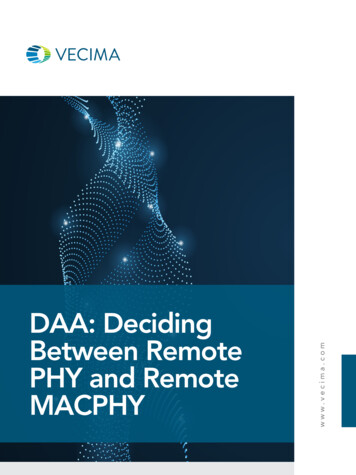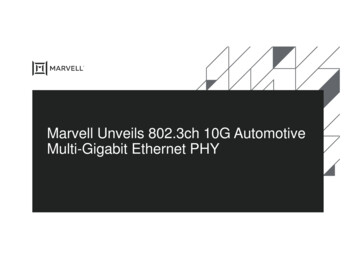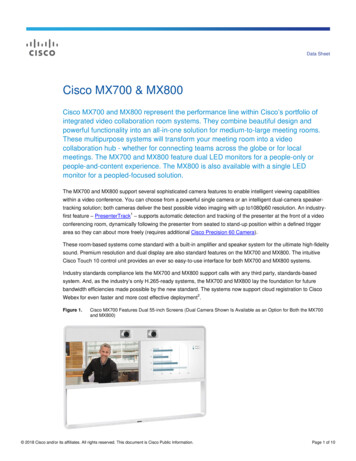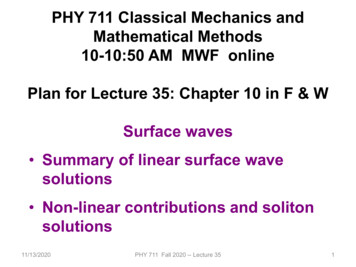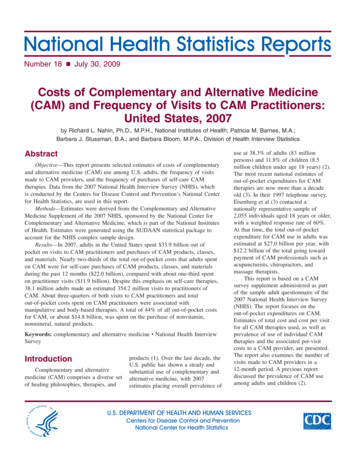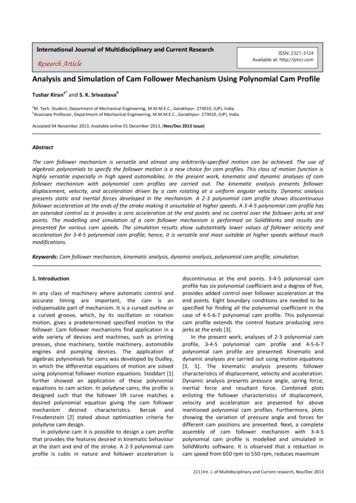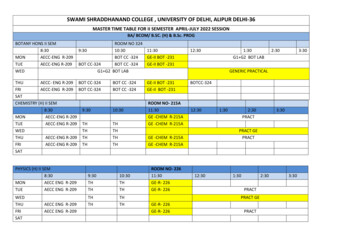
Transcription
CavMagNewsletter Winter 2009January 2010 Issue 3Inside.Editorial:the Return of the Alumni2The Living PastThe Cavendish in 19322Our Understanding of theUniverse is About toChange.4Helium Spin-EchoA Revolution in the Studyof Surface Mechanics5Organic Solar Cells7Physics at Work25th Anniversary8The Cambridge NanoDoctoral Training Centre10Honours, Promotions andPrizes11The Laboratory will Neverbe the Same Without.11The 40th Anniversary of theCavendish’s First Spin-off12CompanyContacts12News from the Cavendish LaboratoryRoyal Opening of the KavliInstitute for CosmologyThe next stage of the Cavendish developmentprogramme became a reality in November2009 with the opening of the Kavli Institutefor Cosmology at Cambridge (KICC) by theChancellor of the University, HRH Prince Philip,Duke of Edinburgh. Sited in the grounds ofthe Institute of Astronomy on Madingley Road,the Institute will form part of an internationalnetwork of research centres funded by the KavliFoundation at other universities around theworld, and will collaborate with its sister centresin China and the USA. The research programmespans a broad range of topics from the physicsof the early Universe, to the formation of thefirst stars and galaxies.make major discoveries in the future.”Professor George Efstathiou, founding Directorof the new Institute said, "We are honouredthat the Chancellor has agreed to open thisnew building. I would like to thank Fred Kavlifor his generous donation and the University fortheir strong support.”The next development challenge is Phase 2of the consolidation of the activities of theInsititute of Astronomy and the CavendishAstrophysics Group.The Kavli Institute brings together, in a speciallydesigned building, about 55 research scientistsand graduate students from three participatingdepartments in the University of Cambridge:the Institute of Astronomy (IoA); the CavendishLaboratory; and the Department of AppliedMathematics and Theoretical Physics (DAMTP).Mr Fred Kavli, founder, Chairman and ChiefExecutive Officer of the Kavli Foundation said,"Cambridge has such a stellar record of makingfundamental discoveries in science throughoutthe ages and, with its traditions of excellenceand leading-edge science teams, I have greathope that the Kavli Institute at Cambridge willwww.phy.cam.ac.ukFrom the left: Mr Fred Kavli, Professor George Efstathiou,the Chancellor and Professor Alison Richard, Vice-Chancellor
Editorial:the Return of the AlumniThe Living PastThe Cavendish in 19321932 was one of the most remarkable years in the history of theCavendish Laboratory. It marked the discoveries of the neutronby James Chadwick and of the ‘splitting of the atom’ by JohnCockcroft and Ernest Walton, details of which are described onthe Cavendish Physics website at www-outreach.phy.cam.ac.uk/camphy/.It was with some trepidation that we organised our first Open Dayfor all alumni on Saturday 26th September 2009. We had received awonderful response to the various communications we had sent outover the last year, but inviting all the alumni back to the Laboratorycould have been a disaster in one of two directions – either no-oneturned up, or the place was inundated and we could not cope.The actual event was the ideal compromise. We entertained about350 alumni and their guests; we were just able to cope and all14 exhibition areas seemed to be busy all afternoon. The majorinnovation was to open the whole Laboratory for alumni and theirguests. We are delighted that everyone responded so positively toour efforts. In fact, with so much on show, few people completedthe full circuit of the Laboratory, but we hope that this means thatwe will have the pleasure of their company next year. As usual,the crowning glory was the enthusiasm of all those explainingthe science to the alumni, particularly the research students andpost-docs. We are most grateful to everyone who made it such amemorable day.To our delight, once the 2009 Alumni Open Day was announced,we were contacted by the son and daughter-in-law of Mrs MarieConstable, née Sparshott, who had joined the Laboratory as agraduate student in 1930. Mrs Constable celebrated her 100thbirthday in 2008. She and members of her family were guests atthe Open Day and were able to see the historical material from the1930s, as well as the research being carried out now. Very kindly,Mrs Constable has written up her experiences as a lone femalegraduate student during the 1930s. Suddenly, this remarkableperiod was brought vividly to life by someone who had been witnessto these events. She writes:In 1930, when I gratefully accepted a research studentship fromAmong the alumni, pride of place must go to Mrs Marie Constable(née Sparshott) who was 101 this year and who was a graduatestudent under James Chadwick from 1930 to 1933. She has kindlyallowed us to reproduce in this edition of CavMag her reminiscencesof that remarkable period.We have already decided to repeat the exercise during AlumniWeekend 2010. There will be some slight variations on theprogramme of 2009. First of all, we will just have one largeSaturday event rather than a small, selective event on the Fridayand the big show on the Saturday. The numbers will be unlimitedon the Saturday. One feature of the Friday event which was muchappreciated by alumni was a presentation by one of the seniorstaff on exciting new developments in physics, especially recentachievements in the Laboratory. We are planning that this will nowtake place on the Saturday.N.S. Alexander. P. Wright. A.G. Hill.W.E. Duncanson. E.C.Childs. T.G.P. Tarrant. J.M. McDougall. R.C. Evans. E.SP.C. Ho. C.B. Mohr. H.W.S. Massey. M.L. Oliphant. E.T.S. Walton. C.E. WynJ.A. Ratcliffe. P. Kapitza. J. Chadwick. R. Ladenberg. Prof. Sir J.J. Thomson. Prof. LordThe plan would be:Laboratory open:General lecture:Refreshments:Wine and nibbles:2.00 to 5.30 pm during which all theresearch areas can be visited4.15 to 5.00 pmAvailable all afternoonFrom 4.00 onwardsWe were delighted to see many young people accompanying thealumni. We will welcome young people in 2010 again – we hopewe can inspire them by the work that excites us so much. So, putthe date in you diary now – Physics Alumni Open Day: Saturday27 September 2010. We look forward to seeing as many of you ascan make it.Malcolm Longair2Cavendish Laboratory staff and graduate students in 1932. There are 9 Nobel PrizeGirton College, I never imagined that, in 2009, I would write a pieceabout what life in the Cavendish Laboratory had been like. TheCavendish in the days of Lord Rutherford was housed in Free SchoolLane. The two main lecture theatres remain unchanged with seatingthat is no more comfortable now than it was then. When takenrecently by Dr Squires to identify the space where I had workedunder the supervision of Dr Ann Davies, I had to rely on finding thewindow with the view I remembered of the tower of St Botolph’sChurch. There we had pored over the spectra of soft X-rays ascaused by bombarding a single crystal of iron with electrons.In those days the Cavendish was a small organisation. LordRutherford was already a much-respected figure. A big, bluff andhearty New Zealander, I found him friendly and helpful. I recall
his habit of making random visits around the laboratory to hisresearch students. Such a visit would start with a loud knock atthe door followed by ‘How are you getting on?’, then ‘Tell me allabout it’ and ‘Anything you want doing?’ He and Lady Rutherfordmade a point, once a year, of inviting all research students tolunch, six at a time at his house on the corner between SilverStreet and the Backs. The food was excellent as was the company.Lord Rutherford also instituted the practice of the laboratoryafternoon tea break. Tea and buns were served every Wednesdayafternoon in the Library, providing an opportunity for anyone tohave a few words with anyone else, and were much valued. Aftertea, all present went to the lecture theatre for a presentation. Thesubject matter might be an interesting idea, or a dry run of a paperbeing prepared for publication. The presenter might be a seniormember of staff or just a research student. Occasionally, we wouldhave a visiting speaker; for example I recall listening to Niels Bohrwho described some of his recent experimental work. A key pointabout these occasions was that anyone present could comment and,if appropriate, challenge the views expressed.I knew Professor Chadwick as the head of the laboratory servicesstaff. He was seen as second-in-command to Lord Rutherford. Hisreputation among research students was that ‘You had to be carefulwith Chadwick because he could get cross’ and, indeed, anyonecompetence in advanced physics. Dr (Daddy) Searle ran thepractical courses in the Cavendish and was a friend. He was notablefor the meticulous nature of his work and the care he took toensure that every single item of apparatus required for the practicalclasses functioned as it should. Turning to fellow research students,Geoffrey Aston had many talents and, for example, was a strikinglycompetent classical pianist. Jack Constable was an engaging, fullof-beans research student who worked in the basement where,under the supervision of Chadwick, he did interesting things withhigh energy α particles - we were married soon after I left theCavendish.So what was life really like in those days? I would describethe Cavendish culture as being serene and decent. Attitudesseemed to be collaborative rather than adversarial. Supervisorsseemed willing to publish papers with their research studentsas co-authors. I still have copies of the paper presented to theRoyal Society by ‘Chadwick, Constable and Pollard’, this paperbeing an interesting precursor to Chadwick’s discovery of theneutron and subsequent Nobel Prize.Although we were witnessing scientific history in the making, Idoubt whether any of the research students thought so at the time.We may have felt that we were privileged to be associated with oneof the world’s premier scientific research establishments, but noneof us suspected that the outcomes of the knowledge thereby gainedwould become strategically important and, in certain circumstances,deeply menacing. The overwhelming motivation was to do with theexcitement of revealing new knowledge and penetrating hithertounexplored intellectual territories.In the light of the long process of obtaining equal university rightsfor women, it might be wondered whether I encountered any suchdifficulties at the Cavendish. As an undergraduate doing Part 2Physics, females were expected to sit only on the reserved frontbench during lectures, for fear their attention might be distractedby too much male proximity. Also, females could quote thequalification but were not entitled to receive a degree at the SenateHouse - a fine distinction. There was very little discriminationagainst female research students - after all, at that time there wasonly me. I can recall just one occasion when difficulties arose.It had been decided that research students ought to have somefamiliarity with workshop practice. A short course was set up inthe lab workshop but I was informed it was not deemed suitablefor females. Outraged, I joined forces with a friend, Helen McGaw,who was doing research in crystallography, and we enrolled at thelocal technical college for a course in workshop practice. Quite soonthe use of hand and machine tools was no longer a total mystery.winners in this picture. Marie Sparshott is second from the right in the second row.J.L. Pawsey. G. Occhialini. H. Miller.S. Shire. E.L.C. White. F.H. Nicoll. R.M. Chaudhri. B.V. Bowden. W.B. Lewis.nn-Williams. J.K. Roberts. N. Feather. Miss Davies. Miss Sparshott. J.P. Gott.d. Rutherford. Prof. C.T.R. Wilson. F.E. Aston. C.D. Ellis. P.M.S. Blackett. J.D. Cockroft.After Jack’s unfortunate death in 1939, I needed some form ofemployment. Eventually, I applied to what was then called HM Inspectorate of Factories and became an inspector. I doubtwhether this job would have been mine without the workshopcourse, although I later became a safety expert in fields where myCavendish experience was highly relevant.Mrs Marie Constablewho misused the lab services or who made silly mistakes was likelyto be informed very clearly of his/her failings. However, I alwaysfound him friendly and kind. Paul Dirac was often seen in theCavendish and regularly attended the Wednesday afternoon teabreak.Dr Patrick Blackett was tall, handsome and helpful. For aprofessional physicist his background was unusual in that he startedas a commissioned officer in the Royal Navy, had a distinguishedrecord in the First World War, and fought in the battle of Jutland.Professor Kapitza, who ran the Mond Laboratory and its lowtemperature work, was a remarkable addition to the Cavendishstaff. Of several contributions he made to life at the Cavendish,one was to dispel any presumption concerning a lack of RussianGeoffrey Constable, Marie Constable (née Sparshott) and Malcolm Longairview the apparatus with which Chadwick discovered the neutron.3
Our Understanding of the Universe is About to Change.The Large Hadron Collider (LHC) is a gigantic scientific instrumentnear Geneva, spanning the border between Switzerland and Franceabout 100m underground. It is a particle accelerator used byphysicists to study the smallest known particles - the fundamentalbuilding blocks of all things. It will revolutionise our understanding,from the minuscule world deep within atoms to the vastness of theUniverse.Two beams of protons - the nuclei of the hydrogen atoms - willtravel in opposite directions inside the circular accelerator. Bycolliding the two beams head-on at very high energy, physicistswill use the LHC to recreate the conditions just after the Big Bang.Teams of physicists from around the world will analyse the particlesthe infamous Higgs boson, the missing piece in the Standard Model.Theory suggests that all of space is filled with a Higgs field, whichis responsible for giving all particles their masses as they ploughthrough it. At the Cavendish, the team is looking for even moreexotic effects. In supersymmetric theories, every particle we knowof, such as electrons, quarks and neutrinos, would have a ‘superpartner’. Detecting and measuring these would revolutionise ourview of physics. Another suggestion, that the Universe has morethan three space dimensions, is equally startling and could open theway to an understanding of quantum gravity.LHCb is an experiment designed to uncover the mystery of thematter-antimatter asymmetry in the Universe and to search for new(i)created in the collisions using special detectors in a number ofexperiments dedicated to the LHC.There are many theories as to what will result from these collisions.For decades, the ‘Standard Model’ of particle physics has servedphysicists well as a means of understanding the fundamental laws ofNature, but it does not tell the whole story. Only experimental datausing the higher energies reached by the LHC can push knowledgeforward, challenging the Standard Model and looking for evidenceof a more fundamental ‘unified’ theory.Cavendish Laboratory physicists have been heavily involved in thedesign and construction of two LHC detectors, ATLAS and LHCb.ATLAS is the largest particle detector ever constructed, roughly thesize of Westminster Abbey, but packed with sensors and electronicsto record and measure the particles produced when the LHC protonbeams collide. Among the debris, scientists hope to find traces of4phenomena in quantum loop processes involving heavy quarks,in particular 'bottom' quarks. Although absent from the Universetoday, these quarks were common in the aftermath of the BigBang, and will be generated in their billions by the LHC, along withtheir antimatter counterparts, anti-bottom quarks. These particlesare unstable and short-lived, decaying rapidly into a range of otherparticles. By comparing the decays of bottom and anti-bottomquarks we can gain useful clues as to why nature prefers matterover antimatter. LHCb is complementary to ATLAS and togetherthey will be capable of discovering new physics over a large energyregime and determining its origin. The UK is the major contributorto LHCb; the Cavendish Laboratory team has provided the readoutelectronics for a major component of the experiment, the RingImaging Cherenkov detectors. These detectors will provide theparticle identification required to separate out the ‘signal’ from the‘background’. The Cambridge team also has the responsibility
to provide the particle identification software and to ensure theexperiment provides excellent quality data.Both the ATLAS and LHCb teams are very much looking forwardto the first data and are well prepared to make measurementsin key areas of the physics programme. Cavendish theorists alsohave an important part to play. For many years they have beenworking alongside their experimental colleagues to help refinethe predictions of the Standard Model and to devise data analysistechniques for uncovering various types of new physics. Thanksin part to this unique combination of experimental and theoreticalactivity, which other groups around the world are seeking toemulate, the Cavendish HEP group as a whole is well placed to playa leading role in LHC physics in the decade to come.For more information visit the HEP group’s web page atwww.hep.phy.cam.ac.ukVal Gibson, Andy Parker and James Stirling(ii)Helium Spin-EchoA Revolution in the Study of Surface MotionMembers of the Surface Physics grouphave recently developed an important newapproach to the study of how atoms andsimple molecules move on surfaces. Thetechnique called ‘helium spin-echo’ (HeSE)involves directing a beam of helium-3atoms at the surface and measuring thechanges in its properties induced by thediffusion of atoms on the surface. Thetechnique provides unique information ontime-scales of the order of 10-12 secondsand on sub-nanometre length-scales, thus opening up a huge newfield of nanoscale surface dynamics research. The nature of atomicscale motion is a subject of intense interest as it provides the basisfor a vast number of technological activities worldwide, in fieldsas diverse as semiconductor development, industrial catalysis, andfuel cell research. There is a long history of helium atom scatteringresearch in the Cavendish, dating back over 25 years. With thedevelopment of HeSE, we now house one of the world’s largest andmost influential ‘atom scattering’ centres.Measuring the two-dimensional motion of atoms on surfaces is asimple idea but, because free atomic motion is extremely fast, withthe atoms travelling between adjacent sites in about a picosecond,it is extremely difficult to measure. Conventional techniques, usingfor example various forms of scanning microscopy, are either muchtoo slow or do not provide the necessary resolution, as in thecase of optical scattering. Despite decades of research, only rathercrude measurements of surface motion have been possible and sounderstanding diffusion, vibration and friction at the atomic levelremains a central experimental challenge in surface science.(ii)(iii)(iv)Top RICH1Bottom RICH2Helium atoms provide an ideal surface probe. High quality beamscan be formed that diffract like other experimental probes, such aselectrons or photons. More importantly, they do not cause damageor influence the surface because they are chemically inert and theatoms need only have very low energies. Typical helium energiesare about 106 times lower than the energies of the electrons in anelectron microscope and helium does not cause localised heating, asis the case with the scanning tunneling microscope.The HeSE apparatus and a quantum mechanical explanation of thetechnique are illustrated in Figs. 1 and 2. A classical analogy of theunderlying physics is that the apparatus can be thought of as anatomic scale version of the familiar radar speed trap. Instead of radiowaves, helium atoms are scattered from atoms or molecules movingover the surface of the sample and the Doppler-like changes in thehelium atom frequency are measured. From these, we can infer thesurface motion of the particles on time-scales from 50 femtosecondsto about 1 nanosecond.Surfaces are a particularly flexible and accessible workbench,on which structures or devices can be examined, and wherefundamental theories can be tested. The HeSE approach enablesfast nanoscale motion to be studied directly for the first time.Although many atom-surface combinations have now beenexamined, three particular examples stand out which illustrate thebreadth of new science.(iii)i.LHCb Collaboration in front of LHCb detctor CERN (photography MaximilienBrice), November 2008 with photographs of the authors.ii.The first collisions observed in the ATLAS experiment of the LHC in November2009.iii.The first images from the Ring Cherenkov detector obtained in November 2009. Spin-echo measurements have been able to identify andcharacterise new, unobserved forms of surface diffusion.For example, benzene on graphite performs unique atomicscale Brownian motion, driven by strong coupling to latticevibrations, rather than the ubiquitous 'hopping' mechanism, asillustrated in Fig. 3.5
Fig. 2: In the spin-echo technique, the nuclei of helium-3 atoms in the beamare spin-polarised using a hexapole magnet. The spins are aligned parallelor anti-parallel to the magnetic field in the solenoid and so are quantummechanically split. The two components move at different speeds in the fieldand so are separated by the ‘spin-echo time’. These components scattersuccessively off any species moving over the surface of the sample. Thescattered components are recombined in the second arm to form a signalcalled the ‘echo’, the strength of which provides a measure of how muchthe surface species have moved during the separation time interval. By measuring the motion of molecules on surfaces we candetermine the forces between them. We have found thatseveral important, well-established models for the interactionsbetween molecules are incorrect, as the information containedin the dynamics of the system has not been considered. Inparticular, models describing the behavior of carbon monoxidemolecules on platinum, probably the best studied catalyticsystem because of its importance in the automotive industry,are seriously flawed. Surfaces provide a simplified geometry for testing theory.Recent measurements of hydrogen diffusion show a transitionbetween classical hopping and quantum tunnelling. The resultstest and support well established, but previously unprovenanalytic models for simple quantum tunnelling scenarios.Fig. 1: The HeSE apparatus consists of a long V-shaped vacuum system. The high intethe left and the detector on the right. Development of the HeSE technique was a majCavendish workshop facilities. The instrument is fully automated and typically runs 24Benzene/GraphiteUnrestricted,continuous diffusion.A measure of the success of the HeSE programme is the 1Minvestment to replicate the Cavendish approach in Israel. Thedifferent experiments performed to date have barely scratched thesurface of those possible and so, rather than competition, we regardthe new instruments as strengthening the emerging field we havepioneered and now lead.The HeSE technique has already had substantial impact in thesurface science community. Given the emphasis on the challengesfacing modern society, such as climate change and new chemicaland fuel technologies, we see an even more important futurerole for HeSE through the application of science and technologyin understanding the basic underlying physics and chemistry. Forexample, the first phonon driven nano-mechanical systems haverecently been constructed and spin-echo studies of phonon drivensystems already provide fundamental physics relating to thesetechnological devices. There is a rosy future for what we expect willbecome the standard approach to the study of diffusion, vibrationand even phase transitions on surfaces.Andy Jardine6ConventionalsystemsEnergy barrierlimited hopping.Fig. 3: Diagrammatic comparison of the interaction between the mobilespecies and surface for the recently observed atomic scale Brownian behaviorfor benzene on graphite (top), and for conventional hopping between siteson a surface (bottom).
the other materials used in solar cell assembly, such as the substrateand encapsulation. The best solution may well be to print the activesemiconductor layers and metal electrodes and tracks directly ontoplastic film. The fastest way to do this would be to use continuousroll-to-roll printing, as in the newspaper industry. This would be avery practical way of producing the vast areas of solar cells that willbe needed when we switch from fossil fuels. These solar cells will belightweight and flexible and so much cheaper and easier to deploythan current systems, which are enclosed in glass sheets.Roll-to-roll printing presents us with some big challenges. We needto develop a completely new materials set, redesign the solar cellsemiconductor architecture and develop the manufacturing skillsthat allow precise control of the printed film thickness. Withinthe University we now have a broad programme of science andengineering to cover this full set of research tasks. Those involvedinclude Professors Sir Richard Friend, Neil Greenham, HenningSirringhaus, Ulli Steiner and Dr Chris McNeill in Physics, ProfessorWilhelm Huck in Chemistry, Professors Mark Welland and AndreaFerrari in Engineering, and Professor Judith Driscoll in MaterialsScience.transportabsorptionensity helium source is at the top centre, the ultra-high vacuum sample chamber tojor undertaking, only made possible through the substantial support provided by thex7, under the supervision of members of the group.Organic Solar CellsSunlight is the most abundant source ofenergy on Earth. It is the origin of theenergy for fossil fuels and for renewableenergy sources such as wind and wavepower, but it is considerably more efficientto use sunlight to generate useful energydirectly. There are two choices – firstly byconcentrating sunlight with mirrors togenerate heat that can be used to driveconventional electricity generators, andsecondly by using arrays of photovoltaic, or‘solar’, cells. Both are feasible technologies, but are still considerablytoo expensive to deploy on the large-scale at present.Solar cells use semiconductors to capture light. Each absorbedphoton raises an electron to a high energy state and this electronis then arranged to drift away from the net positive charge leftbehind, termed the ‘hole’, so that each can be collected at the twoelectrodes to either side of the semiconductor layer. Silicon is anexcellent material for solar cells. It is the right colour, absorbingacross the visible and near infra-red parts of the solar spectrum,and makes reasonably efficient cells. Silicon is not, however, a goodabsorber of light and so relatively thick slabs, typically 0.2 mm,are used and considerable quantities of the material are needed.Unfortunately, semiconductor-grade silicon is expensive and it will bevery difficult to bring down the costs much lower than at present.This concern has stimulated a world-wide drive to find othersemiconducting materials that may provide cheaper solar cells. If weare to reduce the cost of deployment seriously, we need to bringdown not just the cost of the semiconductor materials, but also allchargeseparationPolymer blendIllustrating the electronic structure of interfaces between two differentpolymers. These might be in so-called ‘blends’ where polymers are mixed ona fine scale, sufficiently small to be similar to the exciton diffusion length.Various deposition techniques are used to create many state-of-the artpolymer photovoltaic diodes.Roll-to-roll printing means that the semiconductor materials haveto be handled as ‘inks’ that can be printed at room temperature, avery different world from the traditional high temperature and highvacuum processing world of silicon technology. One very attractiveset of materials are the polymeric organic semiconductors thatFriend, Greenham and Sirringhaus have developed for use in lightemitting diodes. These are already exploited through CambridgeDisplay Technology Ltd and printed transistors, as used in electronicpaper displays, now developed by Plastic Logic Ltd. There is howevera catch. While silicon readily liberates an electron from an electronhole when a photon is absorbed, the excited electron generatedin an organic semiconductor is very reluctant to leave its positivelycharged hole. Nature solved this design problem by the processof photosynthesis in which the excited electron is generated atthe interface between two semiconducting molecules that havedifferent electron affinities. This causes the electron to move tothe adjacent molecule, leaving the hole behind. Subsequent stepsin photosynthesis use the reducing power of the electron and theoxidising power of the hole to do chemistry.7
For solar cells we have the simpler task of arranging that theseparated electron and hole can be collected at their respectiveelectrodes on either side of the device. Some time ago we foundthat single interfaces, or heterojunctions, seem to functionreasonably well but the electron would often move no furtherthan to the adjacent site across the heterojunction, bound byits electrostatic attraction to the positively-charged hole. TheCavendish group are just starting a major EPSRC ProgrammeGrant, worth 6.8M over 5 years, in collaboration with Huck inChemistry and colleagues at Imperial College. The grant supportsa large programme of chemical synthesis, materials processing andsemiconductor physics measurements that will tackle this problem.We plan to develop more controlled heterojunctions that will bebetter at separating the two charges from one another. We needto raise the efficiency of energy conversion from current levels ofabout 5% to at least 10% to be competiti
Newsletter Winter 2009 January 2010 Issue 3 News from the Cavendish Laboratory www.phy.cam.ac.uk CavMag Inside. Editorial: the Return of the Alumni 2 The Living Past The Cavendish in 1932 2 Our Understanding of the Universe is About to Change. 4 Helium Spin-Echo A Revolution in the Study of Surface Mechanics 5 Organic Solar Cells 7 Physics .
